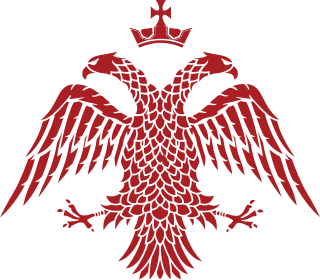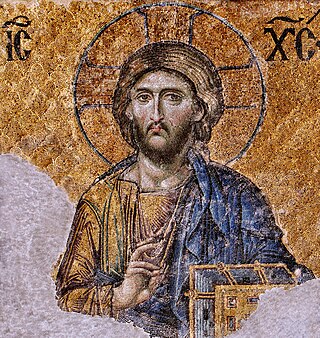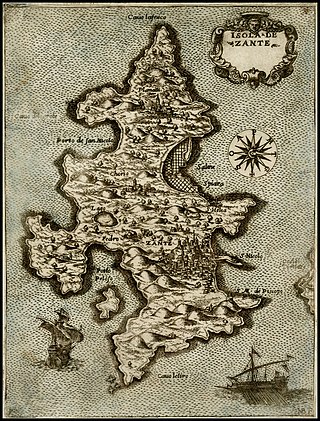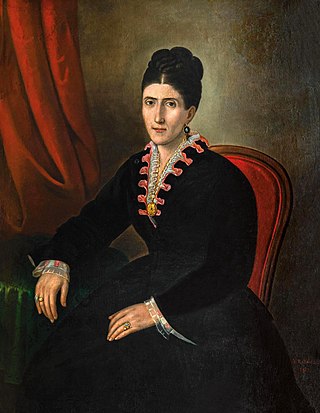
Dionysios Solomos was a Greek poet from Zakynthos, who is considered to be Greece's national poet. He is best known for writing the Hymn to Liberty, which was set to music by Nikolaos Mantzaros and became the Greek and Cypriot national anthem in 1865 and 1966 respectively. He was the central figure of the Heptanese School of poetry. He is considered the national poet of Greece, not only because he wrote the national anthem, but also because he contributed to the preservation of earlier poetic tradition and highlighted its usefulness to modern literature. Other notable poems include Ὁ Κρητικός, Ἐλεύθεροι Πολιορκημένοι. A characteristic of his work is that no poem except the Hymn to Liberty was completed, and almost nothing was published during his lifetime.

Zakynthos or Zante is a Greek island in the Ionian Sea. It is the third largest of the Ionian Islands. Zakynthos is a separate regional unit of the Ionian Islands region, and its only municipality. It covers an area of 405.55 km2 (156.6 sq mi) and its coastline is roughly 123 km (76 mi) in length. The name, like all similar names ending in -nthos, is pre-Mycenaean or Pelasgian in origin. In Greek mythology the island was said to be named after Zakynthos, the son of the legendary Arcadian chief Dardanus.

The Church of Greece, part of the wider Greek Orthodox Church, is one of the autocephalous churches which make up the communion of Eastern Orthodox Christianity. Its canonical territory is confined to the borders of Greece prior to the Balkan Wars of 1912–1913, with the rest of Greece being subject to the jurisdiction of the Ecumenical Patriarchate of Constantinople. However, most of the dioceses of the Metropolises of the New Lands are de facto administered as part of the Church of Greece for practical reasons, under an agreement between the churches of Athens and Constantinople. The primate of the Church of Greece is the archbishop of Athens and All Greece.

Stavrovouni Monastery is a Greek Orthodox monastery which stands on the top of a hill called Stavrovouni in Cyprus; it is sometimes simply known as Stavrovouni. The monastery is one of the few places where one can see a piece of the Holy Cross. Stavrovouni Monastery was founded by Saint Helena and Saint Constantine around 327–329 AD.

Nectarios of Aegina, Metropolitan of Pentapolis and Wonderworker of Aegina, is one of the most renowned Greek saints, venerated in the Eastern Orthodox Church and officially recognized by the Ecumenical Patriarchate of Constantinople in 1961. His feast day is celebrated every year on 9 November.

Ioannis Varvakis, also known as Ivan Andreevich Varvatsi, was a Greek privateer, benefactor, and member of the Filiki Eteria.

Antonio I Acciaioli, also known as Anthony I Acciaioli or Antonio I Acciajuoli, was Duke of Athens from 1403.

December 16 - Eastern Orthodox liturgical calendar - December 18

The Heptanese School of painting succeeded the Cretan School as the leading school of Greek post-Byzantine painting after Crete fell to the Ottomans in 1669. Like the Cretan school, it combined Byzantine traditions with an increasing Western European artistic influence and also saw the first significant depiction of secular subjects. The school was based in the Ionian Islands, which were not part of Ottoman Greece, from the middle of the 17th century until the middle of the 19th century. The center of Greek art migrated urgently to the Ionian islands but countless Greek artists were influenced by the school including the ones living throughout the Greek communities in the Ottoman Empire and elsewhere in the world.

Stylianos Harkianakis was the Greek Orthodox Archbishop of Australia and Primate of the Greek Orthodox Archdiocese of Australia. He served as inaugural and permanent Chairman of the Standing Conference of Canonical Orthodox Churches in Australia and Dean of St Andrew's Greek Orthodox Theological College. He was a theologian specialising in ecclesiology and also an award-winning poet.

August 23 - Eastern Orthodox liturgical calendar - August 25
The Metropolis of Ephesus was an ecclesiastical territory (metropolis) of the Ecumenical Patriarchate of Constantinople in western Asia Minor, modern Turkey. Christianity was introduced already in the city of Ephesus in the 1st century AD by Paul the Apostle. The local Christian community comprised one of the seven churches of Asia mentioned at the Book of Revelation, written by John the Apostle. The metropolis remained active until 1922-1923.

This is a timeline of the presence of Orthodoxy in Greece from 1924 to 1974. The history of Greece traditionally encompasses the study of the Greek people, the areas they ruled historically, as well as the territory now composing the modern state of Greece.

Nikolaos Kantounis or Kandounis was a Greek priest, painter and teacher who did not follow the traditional Maniera Greca. His teacher was the famous painter Nikolaos Koutouzis. He began to incorporate the Maniera Italiana into the Heptanese School. Kantounis, Panagiotis Doxaras, Nikolaos Doxaras and Koutouzis were all prolific members of that school. Kantounis was one of the most important painters in the Neoclassical Period in Greece. He was a representative of the middle to late Modern Greek Enlightenment in Greek art. Over 164 of his paintings have survived. He is known for painting many portraits. Some of his works resemble the style of Nikolaos Doxaras. He was also a member of the secret organization for Greek Independence called the Filiki Eteria.

Zakynthos is a Greek island in the Ionian Sea. It is the third largest of the Ionian Islands. Today, Zakynthos is a separate regional unit of the Ionian Islands region, and its only municipality. It covers an area of 405.55 km2 (156.6 sq mi) and its coastline is roughly 123 km (76 mi) in length. The name, like all similar names ending in -nthos, is pre-Mycenaean or Pelasgian in origin. In Greek mythology the island was said to be named after Zakynthos, the son of a legendary Arcadian chief Dardanus.

Ilias or Elias Moskos was a Greek educator, shipping merchant and painter from Crete. The last name Moskos was associated with three famous painters of the Cretan School alive during the same period, along with Ioannis Moskos and Leos Moskos, possibly his relatives. Elias incorporated maniera greca with the Venetian style. Theodore Poulakis and Moskos brought the art and style of Crete into the Heptanese School of the Ionian Islands. Some of his work was inspired by Angelos Akotantos. He was affiliated with other artists such as Philotheos Skoufos. He is often confused with Leos Moskos. His son was not Ioannis Moskos although they were probably related. Elias most popular painting is Christ Pantocrator. Fifty-two of his paintings survived.

Philotheos Skoufos Greek: Φιλόθεος Σκούφος also known as Filotheos Skoufos. Philotheos was a Greek painter, educator and clergyman during the 17th century. He collaborated with Emmanuel Tzanes on several pieces while he was in Corfu. Philotheos was a member of the Cretan School and Heptanese School. His work was influenced by the Venetian school. He was briefly affiliated with the famous Greek church in Venice San Giorgio dei Greci. Emmanuel Tzanes and Konstantinos Tzanes were also in Venice around the same period and affiliated with San Giorgio dei Greci. He was the priest who presided over famous painter Ioannis Moskos's wedding. Philotheos was active on the Ionian Island while Theodore Poulakis and Elias Moskos also had active workshops. Skoufos most popular works were the Stoning of St Stephen and the Virgin in the Temple.

Dionysios Kallivokas was a Greek portrait and icon painter; associated with the Heptanese School.

Ioanni Korai was a Greek painter that shared the same name as his famous uncle Ioannis Korais. He was a prominent painter on the Ionian Islands. His family migrated to Zakynthos from Chios. He was a member of the Heptanese School. His contemporaries were Dionysios Kallivokas and Nikolaos Koutouzis. He was taught painting by Ioannis Korais. He was active during the Modern Greek Enlightenment and Greek romanticism in art. He influenced countless Greek and Italian painters. Korai brought Greek artwork into the Modern Greek art period. Twelve of his paintings survived. His most notable painting is a portrait of Kyriakos Chorafas painted in 1826. The painting is at the National Gallery of Athens.
Chrysostomos Dimitriou, also known by his episcopal names of Chrysostomos of Zakynthos or Chrysostomos of Trifylia and Olympia, was the Eastern Orthodox bishop of the island of Zakynthos during World War II and the bishop of Trifylia and Olympia postwar until his death.















